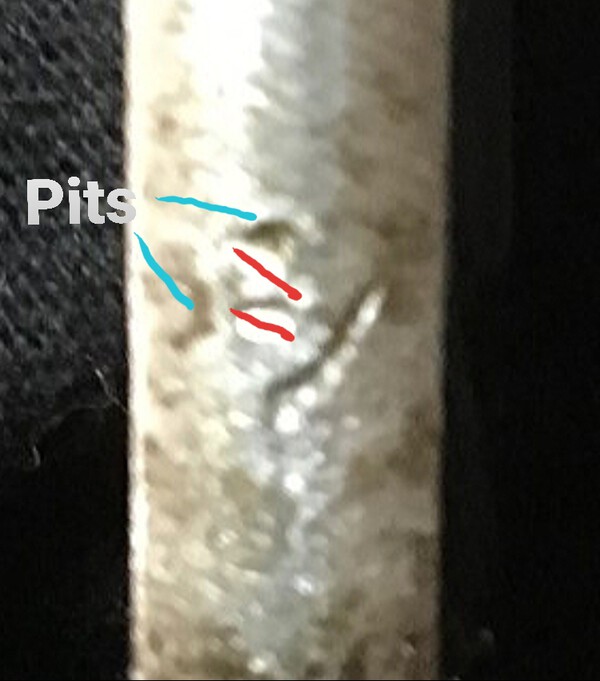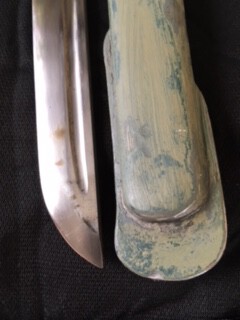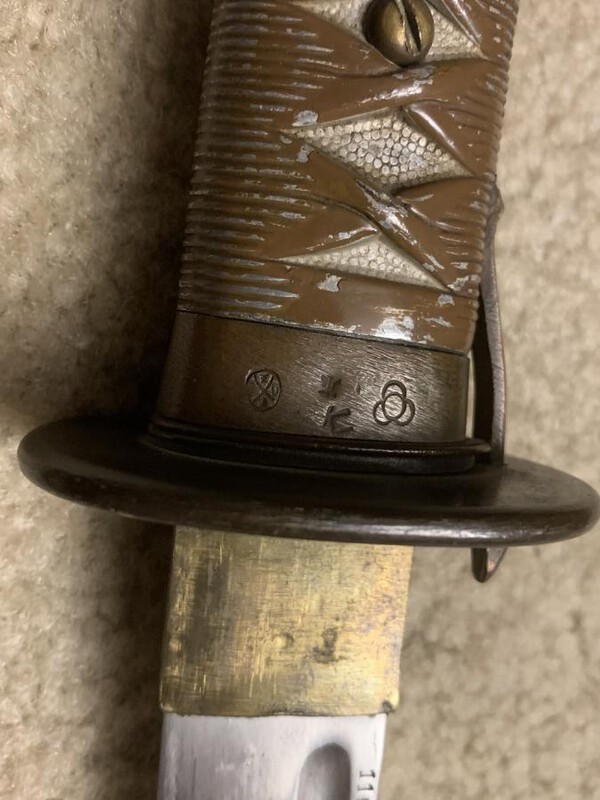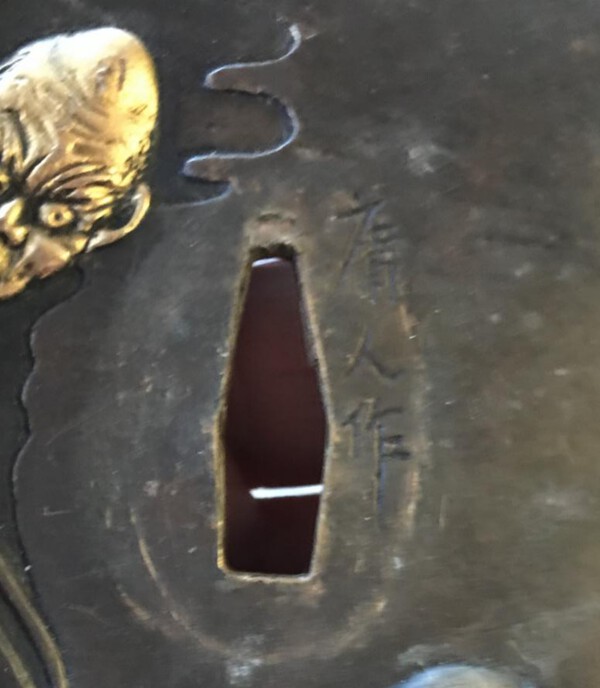-
Posts
13,018 -
Joined
-
Last visited
-
Days Won
155
Content Type
Profiles
Forums
Events
Store
Downloads
Gallery
Everything posted by Bruce Pennington
-

Kawachi Daijo/ Kuni Sada sword - opinions please
Bruce Pennington replied to Dean1981's topic in Military Swords of Japan
As to the fittings - there is quite a variety of mixed civil/military fittings. You can find privately owned blades that made it to the war in every combination from fully re-fitted to full civil and everything in between. You will find some post-war mix/matching done, so it's impossible to 100% say either way. But this one is believable as a war-time partial re-fit for a privately owned sword. -

Attention Mantetsu Owners: A Survey
Bruce Pennington replied to Bruce Pennington's topic in Military Swords of Japan
After your sketch, Neil, I agree with "Shi" シ. It was possible it was TSU ツ or SO ソ, but both of them are 1942 numbers. And while anamolies exists, they are rare. I'm putting this down as a Shi, unless someone puts up a good arguement for something else. Thanks Neil, it's been added. It's been 2 months since I posted the Mantetsu Study document. In that 2 months we've added 13 serial numbers and have made several corrections to existing kanji/serial numbers after a thorough review by Thomas (thanks Thomas!!!). So I've attached the latest version of it for those interested. mantetsu serial numbers (1).pdf -

Attention Mantetsu Owners: A Survey
Bruce Pennington replied to Bruce Pennington's topic in Military Swords of Japan
Neil, good buddy, I'm getting old! Any way you can get a more clear picture of that serial number? Especially that kanji at the top? It's obviously a Koa Isshin - Mantetsu made this; Spring 1943 Serial # ? 304. But there are a couple of kanji that COULD fit that image, but it's mighty blurred. -
Another update to our English terms for WWII Japanese gunto parts, from Thomas over on Warrelics: The Type 95 Military Sword did not have a fuchi but a 柄環 [pronunciation unknown]. The English translation of 柄環 can be either "hilt collar" or "hilt ferrule" depending upon where you are from. Below is the character breakdown for those that want to see the literal translation. 柄 = HEI, tsuka = hilt, handle, grip. 環 = KAN, wa, tamaki = ring, circle. For a list of the parts used on the copper and aluminium handled Type 95's, see the JACAR document C12120578900 below. [Data in English is under preparation] 23.陸普第1164号 兵器修理区分表/(1)刀、剣、槍 Found here: http://www.warrelics.eu/forum/Japanese-militaria/short-development-history-type-95-gunto-676112-11/ So "ashi" is civilian and the military called it a "haikan" 佩環 and the fuchi is called a "heikan" 柄環 on the Type 95 I know the haikan term applies to all gunto, both officer and NCO. I'm checking to see if the "heikan" term is specific to the Type 95 or true for all WWII gunto.
-
- 4
-

-
I know David's thread is mainly about gimei done during the war, but a modern threat that has arisen is the gimei of Mantetsu. I have a couple of examples, made in Japan and sold through Komonjo, that could be wartime, mumei blades that have had the Mantetsu mei added recently. Additionally, we have heard of Chinese efforts to create fake ones. I could see the need for future shinsa teams to identify real/fake showato.
-
Well, they have already begun with the Mantetsu we saw papered.
-
Agree with Dave. Help me clarify "remount". Does the blade have 2 mekugi ana? Or are you assuming that it was made for military mounts, since it was a Seki-made blade? Kevin Jone's (Ryujin Swords) article states that both swordsmiths and collectors were the people agitated by the gimei showato, so sounds to me like civilian collectors were buying swords. There is no reason to believe that ALL blades made during the war were sold to the military. Like Dave said, there is evidence that some swords were made and sold on the civilian market in civilian koshirae. HOWEVER, the article's other implication is that ALL blades, no matter how fitted, or who sold to, would be stamped if non-traditionally made. So, all I can tell you is that, to me, the odds are in favor that this blade was made before 1940 (when stamping became the norm). Realistically, could a smith have made a sword for a private purchace to a civilian and not stamped it, regardless of the year? Well, yes, that is possible. We all know about the exceptions to the rule in this world of collecting we are in.
-
I'm pretty certain the Type 94 began the mass-produced, oil-quenched showato we are discussing that COULD be seen with a gimei, so 1934 onward. My point about increased Army control and supervision, is that the order to stamp blades didn't happen until 1938. Army total control of all blade production didn't kick in until 1940 or later, with increasing control/supervision (think Jinsen & Mantetsu) in 1942 and beyond. This increased supervion, over time, would make gimei showato harder to get to the customer as time went on. SO, if we see a gimei showato, it is my guess it would come in the early years that generated the govt's need in 1938 to institute the stamping requirements.
-
I wonder if this possibly explains the mottled green we have discussed a couple of times? http://www.militaria.co.za/nmb/topic/29130-mottled-green-paint-on-type-95s/?hl=%2Bmottled+%2Bgreen http://www.militaria.co.za/nmb/topic/23681-nco-saya-paint/?hl=%2Bgreen+%2Bsaya
-
Like Austus, I know little about nihonto. But from how I read the history of why the stamps were directed, I assumed "they" were making blades the traditional way, even water quenching, but were using other steel, not tamahagane - therefore non-traditional - AND faking mei (gimei). Remember, this was becoming a problem in the mid-late 1930's. Many of the showato we see today, in Collecting-world, were made in the '40s. So, examples that would fit David's original topic would likely have come from the '30s, in my opinion. I would think gimei showato would be harder to find after the Army grew in it's oversight and inspection as the years went by (obviously, not extinct, just less).
-
Jean, It is a fact. The whole reason the Govt ordered the stamping of blades was precisely because showato were being produced, gimei, that could not be identified from the real thing. "HISTORY From Ryujin Swords Kevin Jones (http://ryujinswords.com/shostamp.htm): “Tang stamps were introduced precisely because swordsmiths and collectors could not distinguish the best quality non-traditional swords (i.e. ‘mill steel’ gendaito) from traditionally made swords. It was discovered that, as a result, some smiths were forging replicas of older swords, giving them false signatures (gimei), and passing them off as the real thing. Several smiths were subsequently arrested. Amidst mounting concern, the government passed a law requiring all swords that were non-traditional in any way to be marked with a tang stamp, although the actual stamp used was left to the manufacturer."
-
I remember now - it was Stegel's thread about the "transitional tsuba" -http://www.militaria.co.za/nmb/topic/30699-type-95-transitional-tsuba/
-
Ha, thanks Stephen! It’s the star-shaped roku. My head sees 5 points so I think FIVE.
-
I was trying to remember where a discussion took place about the transition for the Jinsen Arsenal to start producing swords. I can't find it. The reason is that there is a Type 95 posted on Wehrmacht-Awards - http://www.wehrmacht-awards.com/forums/showthread.php?t=1032195, showing a Kokura stamped, Tokyo instpected Iijima manufactured blade that has an additional "仁" (Jin) stamp. The Kokura stamp puts the manufacture of this blade no later than 1940. So this would appear to be a gunto provided by the Tokyo Arsenal to the Jinsen arsenal for maybe an example for the team starting up production?
-
Army Type 98 - June 1941 (I get the 5 and 6 mixed up too, Neil!) Navy Type 97 You can read about them both here: http://ohmura-study.net/902.html
-
Neil, Ok, I see the focus of your question. It was more narrow than I thought. I took it too broadly, and my feelings on the broader question would be better off in another thread, else your question goes unanswered. David, I'll start a thread to discuss my meaning.
-
You stirring the pot, Neil?!?! Ha! My feelings on this are the same as my feelings on the "Race" question on forms - IT'S HUMAN RACE!!! There ARE NO other races on this planet! In the same vein, Nihon-to are Japanese Swords - so if a sword was made by a Japanese man - it's NIHONTO. All nihonto, in this context, should then be evaluated for all the same criteria that make them beautiful. Either they have it or they don't. Like I said on another thread, this is an ageless battle between traditionalists and "modernists" (for lack of a better term). Traditionalists want things to stay the same, regardless of whether they SHOULD stay the same or not. I'll admit, there are some things that shouldn't change (just ask any conservative); but to create a caste-system for sword blades seems to miss the whole point of enjoying the art of a blade. Either it's purdy or it ain't. Why would it matter where the patch of dirt was located when the steel was mined? Either it's beautiful or it ain't. But nobody asked me when they started this battle.
-

Attention Mantetsu Owners: A Survey
Bruce Pennington replied to Bruce Pennington's topic in Military Swords of Japan
I have to say the kanji marks are quite shiny. The Iroha system seems to have been closely followed. So much so that if you gave me a serial number alone I could tell you the year. I think I’ll file this one in the “Possible Fakes” file. -

Attention Mantetsu Owners: A Survey
Bruce Pennington replied to Bruce Pennington's topic in Military Swords of Japan
I'm sorry to hear that, but thanks for the warning Trystan. Poor picture, but it appears that they will be off on the mei and the quality of the nakago looks poor. It's a bit surprising that they would attempt a Mantetsu since the quality workmanship is so high. But then, quality standards have never stopped them with any other type either. *Sigh* -
Dang Neil. That's gorgeous and I'm just seeing 1% of the gunto! I've always like the crossed arrows.
-

Japanese Calvary and Artillery Sword
Bruce Pennington replied to waljamada's topic in Military Swords of Japan
That was my feeling when I first held mine! I expected something wiggly, but they are a serious blade. -

Japanese Calvary and Artillery Sword
Bruce Pennington replied to waljamada's topic in Military Swords of Japan
Adam you got an incredible deal! Those are Type 32 swords, originating in 1899 and produced through 1925. They made around 8,000/yr so you can do the math and estimate the years of your swords. The length will tell you if they are a Ko or Otsu version. Ko is 39" in scabbard and Otsu is 36" Someone with experience will have to help with the cosmolean. It was a goop the returning G.I.s put on steel souvenirs. Pure alcohol (find it at hardware stores) couldn't hurt the blade. -
Some guys will do anything for attention!





